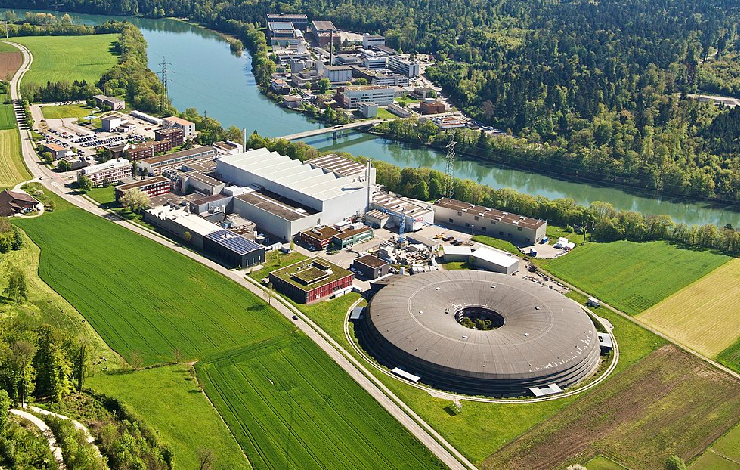26-05-2025

In the photo: Paul Scherrer Institute (PSI)/Wikipedia
An international team of researchers, including scientists from the NOVA School of Science and Technology (NOVA FCT), the School of Science and Technology of the University of Coimbra (FCTUC), and the University of Aveiro, has achieved an unprecedented measurement of the nuclear radius of helium-3 with unparalleled precision. The result, now published in the prestigious journal Science, serves as a rigorous test of atomic physics theories.
The experiment took place at the Paul Scherrer Institute (PSI) in Switzerland, using the most intense muon beam in the world. Researchers from the CREMA Consortium (Charge Radius Experiment with Muonic Atoms) replaced the electrons in the helium-3 atom with muons — subatomic particles about 200 times heavier than electrons — thus forming so-called muonic helium-3. This configuration enabled an extremely precise determination of the nuclear charge radius, measured at 1.97007 femtometers (one meter contains a thousand trillion femtometers).
The Portuguese team played a crucial role in several aspects of the experiment, particularly in developing the X-ray detection systems, experimental control, and theoretical calculations. In total, ten Portuguese researchers participated: five from the Faculty of Science and Technology of the University of Coimbra (Luís Fernandes, Fernando Amaro, Cristina Monteiro, Andrêa Gouvêa, and Joaquim Santos), three from NOVA School of Science and Technology (Jorge Machado, Pedro Amaro, and José Paulo Santos), and two from the University of Aveiro (Daniel Covita and João Veloso).
The Paul Scherrer Institute (PSI) in Switzerland is currently the only facility in the world capable of generating slow negative muons in sufficient quantities for this type of research. The success of the measurement was also due to the use of a sophisticated laser system, which accurately detects the resonance frequency at which the muon undergoes an energy transition, resulting in the emission of X-rays.
The newly obtained data significantly contribute to the theoretical modeling of nuclear structure and are fundamental for testing quantum electrodynamics (QED) in bound systems such as atoms. Additionally, they provide critical reference values for nuclear models based on fundamental principles of physics.
These models allow for a better understanding of the force that binds protons and neutrons within the nucleus — the strong force. Moreover, the precise determination of these radii enables stringent tests of quantum electrodynamics (QED) in simple systems like atoms, allowing for high-precision assessments of how reliable our understanding of atomic structure truly is.
The CREMA consortium is planning new experiments, including analysis of hyperfine structure in muonic atoms and new measurements using muonic hydrogen, aiming to further explore the limits of fundamental physics.
This work was supported by the European Research Council, Swiss National Science Foundation, German Research Foundation, Portuguese Foundation for Science and Technology (FCT), among others.
In the press
10 cientistas portugueses põem à prova teorias da física atómica e ajudam a medir núcleo do hélio-3, Sapo TEK
Cientistas portugueses ajudam a medir o núcleo do hélio-3, Região Sul
Investigadores portugueses participam em experiência inédita no mundo, Bom Dia